
 |
Tea Clipper |
 |
| from TeaAntiques.com | ||
| Edition Ninety Three |
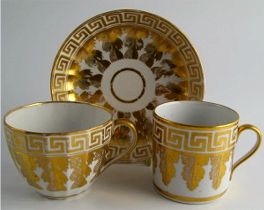 A superbly decorated trio comprising a 'faceted' melon shaped
tea cup, saucer and straight sided coffee can. Each is beautifully decorated in a
rich honey coloured gilding in the Regency taste, c1810. Although these pieces
are not marked with any manufacturer's marks, I believe that they are probably
from the Chamberlain Worcester factory - the gilding is of very high quality
that I would expect from the Chamberlain Worcester factory at this period.
A superbly decorated trio comprising a 'faceted' melon shaped
tea cup, saucer and straight sided coffee can. Each is beautifully decorated in a
rich honey coloured gilding in the Regency taste, c1810. Although these pieces
are not marked with any manufacturer's marks, I believe that they are probably
from the Chamberlain Worcester factory - the gilding is of very high quality
that I would expect from the Chamberlain Worcester factory at this period.
The exquisite decoration comprises the 'Regency' Greek Key design, below which are dropping gilt leaves. The leaves are cleverly depicted with one half in solid gilt form and the other half delicately showing the leave veins and then cross hatched. This treatment of the leaves provides a good dimension to the decoration and makes it shine out well.
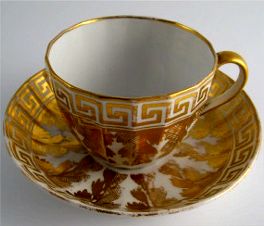
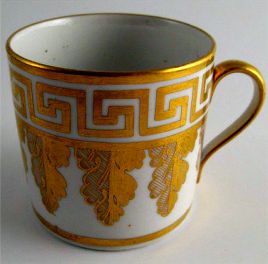
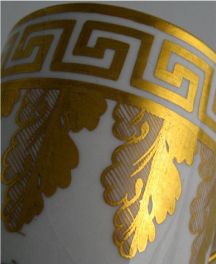
This trio is a very nice 'cabinet' piece for display with its very rich gilded decoration. However, there is some damage to the pieces as described in full on my web-site more detailed description.
More details of this item and other tea related antiques can be found by visiting my web site at www.TeaAntiques.com.
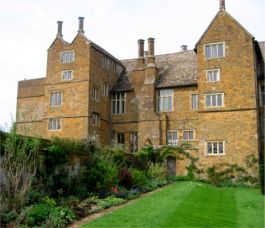 There
are a few things that set this house apart from many stately homes open to the
public. Still a family home, you are quite likely to see Lord
and Lady Saye and Sele during a visit. It is one of the few houses that
allows photography inside the house as well as allowing visitors access to the
roof in order to gain views of the formal garden.
There
are a few things that set this house apart from many stately homes open to the
public. Still a family home, you are quite likely to see Lord
and Lady Saye and Sele during a visit. It is one of the few houses that
allows photography inside the house as well as allowing visitors access to the
roof in order to gain views of the formal garden.
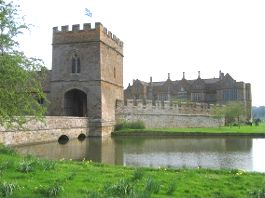 The
house has a very early history and is sited at the junction of three streams.
The original manor house was built in 1300 by Sir John de Broughton, much of
this house and the moat built to surround it survives to this day. In 1377 the
house was purchased by William of Wykeham who was the Bishop of Winchester,
Chancellor of England and founder of New College, Oxford. From him the house
passed to his great-nephew, Sir Thomas Wykeham and on to his granddaughter,
Margaret, who married Sir William Fiennes, later second Lord Saye and Sele.
Through the subsequent generations it remains in the Saye and Sele family.
The
house has a very early history and is sited at the junction of three streams.
The original manor house was built in 1300 by Sir John de Broughton, much of
this house and the moat built to surround it survives to this day. In 1377 the
house was purchased by William of Wykeham who was the Bishop of Winchester,
Chancellor of England and founder of New College, Oxford. From him the house
passed to his great-nephew, Sir Thomas Wykeham and on to his granddaughter,
Margaret, who married Sir William Fiennes, later second Lord Saye and Sele.
Through the subsequent generations it remains in the Saye and Sele family.
During this remarkably long history, the house and family have seen many events. William, eighth Lord Saye and Sele was a strong Parliamentarian and opposed King Charles I's efforts to rule without a Parliament. During the Civil War, William and his four sons actively supported the Parliamentarians and fought at the nearby battle of Edgehill in 1642. By the early nineteenth century things had changed and the William Thomas, son of the fourteenth Baron was one for a frivolous and extravagant lifestyle and was in the set of the Prince Regent, later King George IV. In this period in the nineteenth century the family mainly lived in their other home in Kent, and Broughton fell into neglect and much of the content was sold off. Now the family have been carrying out major restoration work to bring the Castle back to its full glory.
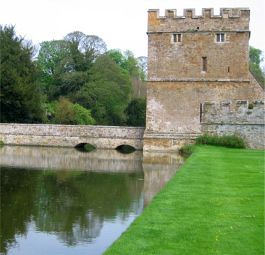
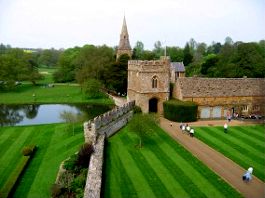
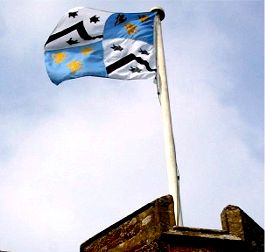
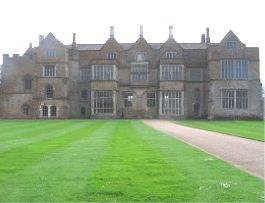
As a military type of fortress, the house is moated and fortified with battlements and access to the house is via a stone bridge and gatehouse. This gatehouse dates from the fourteenth century, was damaged during the Civil War and repaired in the mid seventeenth century. From the battlements of the gatehouse flies the families standard with their family Coat of Arms. Passing through the archways of the gatehouse affords the first view of the house in front of you, with its large stone mullion windows and towering chimneys.
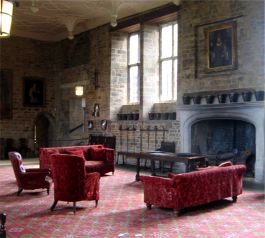 Entering
the house you find yourself in The Great Hall. This large room incorporates the
original medieval hall of 1300. The walls had the plaster removed in 1900 thus
leaving plain rubble stone construction. The windows are set high, are large
allowing light to steam into the hall. A huge open stone fireplace is sited on
the wall opposite and there is an eighteenth century plaster ceiling. Around the
room on the fireplace and window ceils are a collection of leather fire buckets,
these dating from the eighteenth century. To give the room an air of comfort, it
houses a suite of red plush furniture of settees and armchairs. various suits of
armour adorn the walls.
Entering
the house you find yourself in The Great Hall. This large room incorporates the
original medieval hall of 1300. The walls had the plaster removed in 1900 thus
leaving plain rubble stone construction. The windows are set high, are large
allowing light to steam into the hall. A huge open stone fireplace is sited on
the wall opposite and there is an eighteenth century plaster ceiling. Around the
room on the fireplace and window ceils are a collection of leather fire buckets,
these dating from the eighteenth century. To give the room an air of comfort, it
houses a suite of red plush furniture of settees and armchairs. various suits of
armour adorn the walls.
Moving out of the Great Hall, the next room is the Dining Room. This room was an undercroft in the medieval house and would have been a principle store room. It still retains its vaulted stone ceiling and stone walls and thus looks rather strange to be filled with elegant eighteenth and early nineteenth century dining furniture. On the sideboard stands a Regency tea caddy, with brass feet and lion mask loop handles.
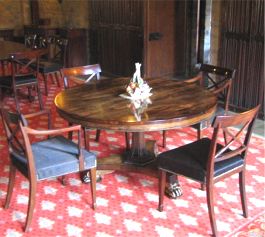
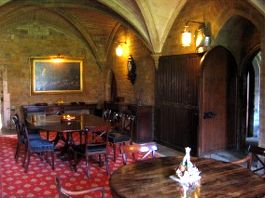
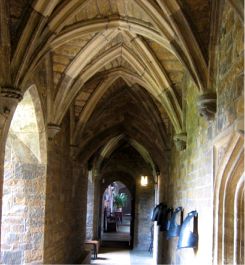
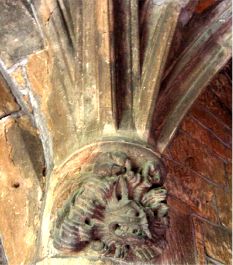 From
the Dining Room a stone Groined Passage, lined with armour breast plates, leads
to winding stairs which take you up to The Gallery and at one end of this
gallery is Queen Anne's Room, a beautiful yellow bedroom. This bedroom is thus
named as Queen Anne of Denmark, wife of King James I slept in this room in 1604
and whose portrait hangs above the fireplace. There is a magnificent carved
stone fireplace that dates from 1551, this having elaborately carved pillars
supporting an equally elaborate frieze. An elegant mahogany four poster bed is
sited at one end of the room, this hung with pale gold and cream hangings. In
one corner of the room a window affords a view into the private family chapel.
From
the Dining Room a stone Groined Passage, lined with armour breast plates, leads
to winding stairs which take you up to The Gallery and at one end of this
gallery is Queen Anne's Room, a beautiful yellow bedroom. This bedroom is thus
named as Queen Anne of Denmark, wife of King James I slept in this room in 1604
and whose portrait hangs above the fireplace. There is a magnificent carved
stone fireplace that dates from 1551, this having elaborately carved pillars
supporting an equally elaborate frieze. An elegant mahogany four poster bed is
sited at one end of the room, this hung with pale gold and cream hangings. In
one corner of the room a window affords a view into the private family chapel.
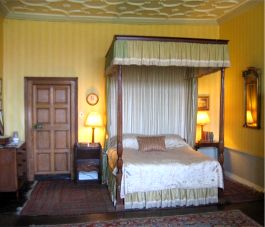
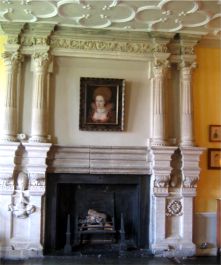
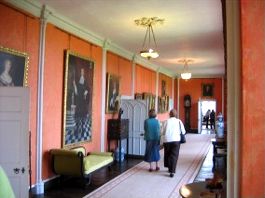
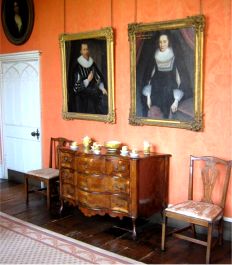 Moving
back into The Gallery, which is a long room lined with family portraits,
interesting furniture and some fine porcelain. Here there is a change of
architectural style where we now see a Gothick influence. This Gothick style was
introduced into this room c 1760's and is particularly noticeable on the moulded
arched style of the carved doors. Although the guide book is not very
informative on the smaller items of porcelain within the house, the guides in
the rooms do have some guide books which do have more detail and they are more
than happy to inform you of anything you should wish to know. Amongst the
porcelain was a beautiful Paris porcelain tea service, with a bright
yellow ground on which were black monochrome scenes. Other pieces in the room
included manufacturers such as Derby and Coalport from the late eighteenth and
early nineteenth century in styles varying from floral to Imari.
Moving
back into The Gallery, which is a long room lined with family portraits,
interesting furniture and some fine porcelain. Here there is a change of
architectural style where we now see a Gothick influence. This Gothick style was
introduced into this room c 1760's and is particularly noticeable on the moulded
arched style of the carved doors. Although the guide book is not very
informative on the smaller items of porcelain within the house, the guides in
the rooms do have some guide books which do have more detail and they are more
than happy to inform you of anything you should wish to know. Amongst the
porcelain was a beautiful Paris porcelain tea service, with a bright
yellow ground on which were black monochrome scenes. Other pieces in the room
included manufacturers such as Derby and Coalport from the late eighteenth and
early nineteenth century in styles varying from floral to Imari.
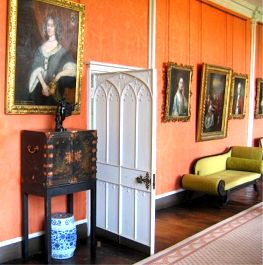
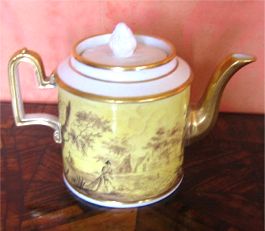
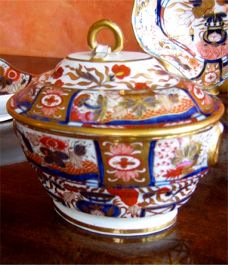
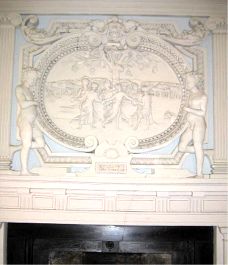 Half
way along The Gallery and off to one side is The King's Bedchamber. This room
has the most splendid fireplace dating from 1554. The top half of this great
fireplace is moulded stucco, while the lower half is of carved stone and is
French in origin. There have been two Kings sleep in this room, first was James
I in 1604 and later Edward VII in 1901. The walls are hung with an attractive
hand painted eighteenth century Chinese wall paper decorated with pretty birds,
flowers and foliage. The bed in this room is modern, made in 1992 in oak and
comes as somewhat of a surprise in this old house.
Half
way along The Gallery and off to one side is The King's Bedchamber. This room
has the most splendid fireplace dating from 1554. The top half of this great
fireplace is moulded stucco, while the lower half is of carved stone and is
French in origin. There have been two Kings sleep in this room, first was James
I in 1604 and later Edward VII in 1901. The walls are hung with an attractive
hand painted eighteenth century Chinese wall paper decorated with pretty birds,
flowers and foliage. The bed in this room is modern, made in 1992 in oak and
comes as somewhat of a surprise in this old house.
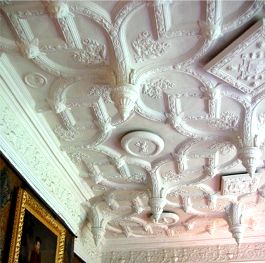
Making your way back into The Gallery, this then leads into The Great Parlour at the west end. The first thing to take your eye here is the ceiling. It is a stunning strapwork plaster ceiling dating from 1599 and in panels bears the initials REF - Richard and Elizabeth Fiennes as well as this 1599 date. There are a few items of particular interest, these a really miniature dolls teaset, housed under a glass dome and the rich red and ermine trimmed robe and coronet of the Earl.
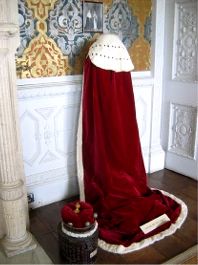
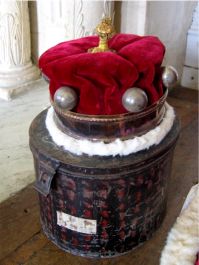
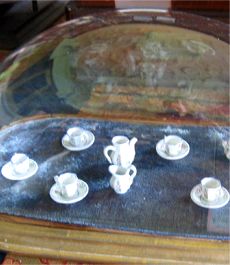
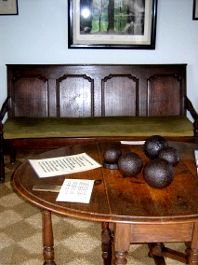 From
the Great Parlour and via several narrow twisting stair cases you make you way
up to The Council Chamber, a small room used in the period 1629-1640 for those
gathered to plan the opposition to the King's government. Here on the table are
some of the cannon balls from the Civil War, a marked reminder of the turbulent
time in British history.
From
the Great Parlour and via several narrow twisting stair cases you make you way
up to The Council Chamber, a small room used in the period 1629-1640 for those
gathered to plan the opposition to the King's government. Here on the table are
some of the cannon balls from the Civil War, a marked reminder of the turbulent
time in British history.
 Just
outside The Council Room are some steps that lead you through a door and out
onto the roof of the house. This was very exciting to be so high above the moat
and formal gardens of the castle and to actually be allowed to wall on the
leaded roof around the parapet wall - not a thing the National Trust would ever
allow! The views of the formal gardens, moat and English landscape beyond were
breathtaking.
Just
outside The Council Room are some steps that lead you through a door and out
onto the roof of the house. This was very exciting to be so high above the moat
and formal gardens of the castle and to actually be allowed to wall on the
leaded roof around the parapet wall - not a thing the National Trust would ever
allow! The views of the formal gardens, moat and English landscape beyond were
breathtaking.
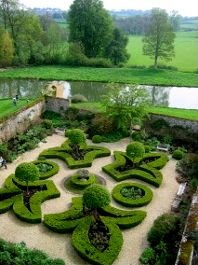
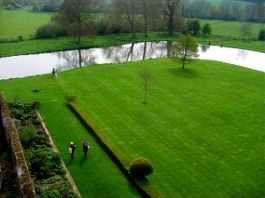
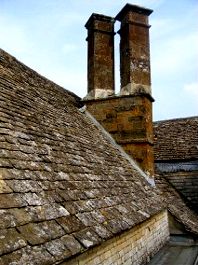
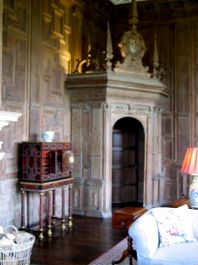 Taking
a staircase back down to the ground floor, one of the last principle rooms to see
was The Oak Room, thus named because the walls are lined with carved oak
panelling. It has a corner carved oak porch through which you enter the room,
this has a carved cartouche at the top on which is inscribed 'uod olim fuit
meminisse minime iuvat - 'there is no pleasure in the memory of the past'.
In my opinion there is a lot of pleasure in the memory of the past especially
when looking round such a fascinating old house.
Taking
a staircase back down to the ground floor, one of the last principle rooms to see
was The Oak Room, thus named because the walls are lined with carved oak
panelling. It has a corner carved oak porch through which you enter the room,
this has a carved cartouche at the top on which is inscribed 'uod olim fuit
meminisse minime iuvat - 'there is no pleasure in the memory of the past'.
In my opinion there is a lot of pleasure in the memory of the past especially
when looking round such a fascinating old house.
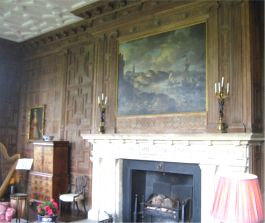 Over
the stone fireplace is a large seascape which shows the coast of Holland at
Scheveningen, from where King Charles II sailed to England in 1660 for the
restoration of the monarchy. In this room are some fine pieces of furniture,
including a chest on stand with beautiful marquetry inlay and also a fine
Regency mahogany teapoy, standing on a slender column with three spay feet and
terminating in brass casters.
Over
the stone fireplace is a large seascape which shows the coast of Holland at
Scheveningen, from where King Charles II sailed to England in 1660 for the
restoration of the monarchy. In this room are some fine pieces of furniture,
including a chest on stand with beautiful marquetry inlay and also a fine
Regency mahogany teapoy, standing on a slender column with three spay feet and
terminating in brass casters.
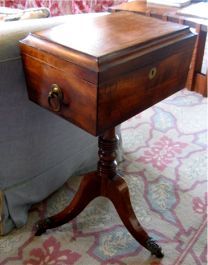
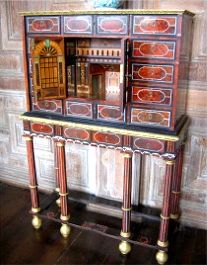
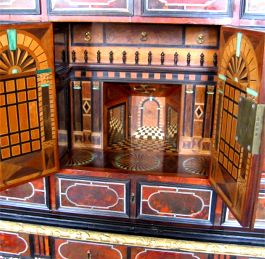
Before leaving the house and entering the formal garden, there is a hall in which stands a break front cabinet containing a collection of family porcelain, including many items of tea wares. Included are eighteenth century Chinese 'armorial' export wares and Meissen floral decorated wares of the same period.
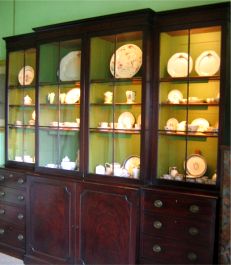
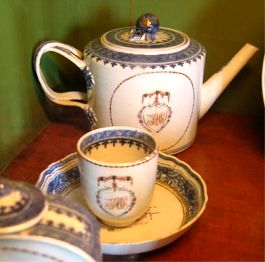
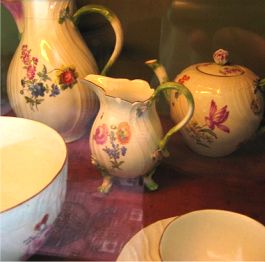
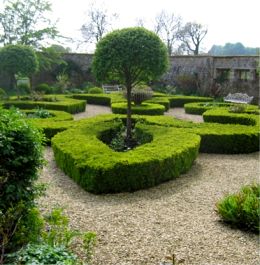
Leaving the house you enter the formal garden which has a completely different perspective to the view of it from the roof of the house. This charming walled garden, known as the 'Ladies Garden', was laid out in the 1880's with formal shaped box hedging and a mixture of flowering plants and roses. The four main box shaped beds are of Fleur de lys and are set around a central circular water feature.
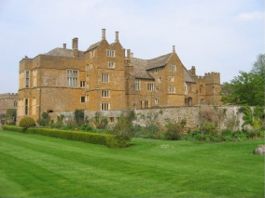
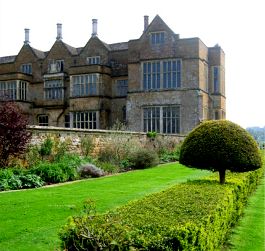
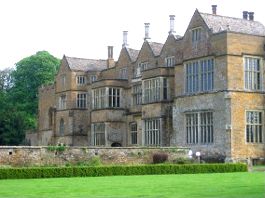
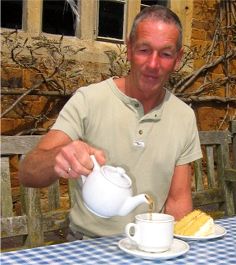
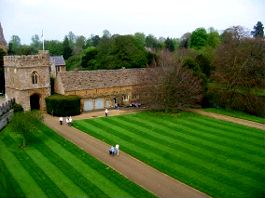 It
is worth taking a wide sweep to walk along the moat as it gives some very fine
views of the Castle. Before leaving you may wish to take tea in the Castle
tearoom, which is in part of the garage / stable block adjacent to the
gatehouse. Here, although the choice may be quite limited, you can enjoy a pot
of tea with a slice of home made cake and if you are blessed with a fine day,
enjoy this outside over looking the Castle.
It
is worth taking a wide sweep to walk along the moat as it gives some very fine
views of the Castle. Before leaving you may wish to take tea in the Castle
tearoom, which is in part of the garage / stable block adjacent to the
gatehouse. Here, although the choice may be quite limited, you can enjoy a pot
of tea with a slice of home made cake and if you are blessed with a fine day,
enjoy this outside over looking the Castle.
To review past newsletters, just follow this link:
Past newsletters.
To subscribe to this free newsletter -
Click here